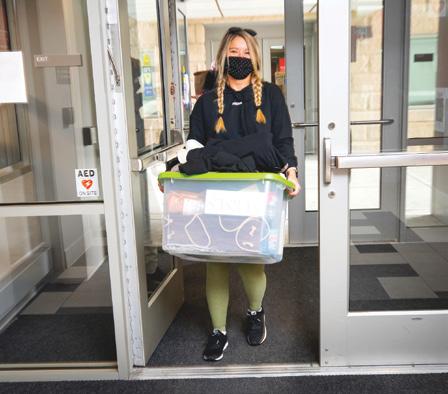
20 minute read
CAMPUS NEWS
esu reMains on track for fall 2021 re-opening of campus
Plans remain firmly in place for students, faculty and staff to return to ESU’s campus for fall 2021, according to Interim President Kenneth Long. Course registration and room selection took place starting in April. New scholarship awards are in place for first generation and transfer students and classroom spaces are being continuously reviewed to ensure appropriate COVID-19 guidelines and technological advancements are in place. “There’s a great surge of excitement and energy about the fall 2021 semester,” said Long. “For those of us who have been working from campus throughout the pandemic, we are eager to see and interact with more students. Others, particularly faculty who have been teaching most of their classes online, want to be back in our academic spaces and are planning for more face-to-face instruction. We’ve been working toward a safe re-opening of our campus since we initially announced our plans last fall.” In spring 2021, ESU welcomed back nearly 300 students who opted to live in on-campus housing. Approximately 100 classes took place via face-to-face instruction. ESU’s plan for fall 2021 is to have the majority of classes be face-to-face through both traditional face-to-face where classrooms can accommodate social distancing protocols and hybrid delivery. Hybrid instruction is a combination of face-to-face classroom learning and online learning in which students are expected to attend synchronous instruction in-person alternating with online/virtual attendance. Long announced that part of the readiness to return ESU to a “new normal” is based on the swift distribution of a COVID vaccine nationwide as well as the declining spread of the virus in Pennsylvania, particularly Monroe County. “We still understand that the threat of COVID is real,” says Long. “All members of the campus community (and visitors) will continue to be required to follow all CDC and Pennsylvania Department of Health guidelines. Wearing masks will be required. We will also administer regular COVID testing. The safety of our campus and local community members remains a top priority.” “We are very aware that our current and prospective students are eager to exchange their current remote learning for in-person experiences in the classroom, the residence halls and in other facilities across campus. A successful return to ESU will require all of us to be committed to doing our part in order to maintain the safety of the entire campus community, both on and off-campus. This semester, we expanded the number of students living on-campus to gauge how the campus community will handle the responsibilities of personal safety, as well as the safety of one another, and make necessary adjustments for our fall 2021. We were pleasantly surprised by the responsible actions taken by many of our students.” ESU also understands that the COVID pandemic has heightened financial hardships for students and their families. New for fall 2021 are ESU’s Gen One Scholarships for students who are the first in their family to attend college, and a series of Platinum/Gold/Silver Transfer Scholarships for transfer students from select regional community colleges. “We know this has been an extremely difficult year for many students who have had to face many personal challenges that have caused them to take a closer look at their financial viability to go to college,” said Karen Lucas, vice president for enrollment management. “That’s why we want to place such an emphasis on providing these students with affordable and accessible academic opportunities.”
Advertisement
About 300 students returned to campus to live in residence halls in January 2021. This fall, ESU is preparing for a full re-opening with a mix of traditional face to face and hybrid classes. Photo by Susie Forrester
art + design faculty, students work together to make better face shields
Students and faculty in the art + design department worked to enhance personal protective equipment using ESU’s 3D printing Stratasys Super Lab. Courtesy Photo
In the midst of the pandemic that left so many people feeling isolated, two East Stroudsburg University professors and three students collaborated on designing face shields that can make human contact safer and communications easier. The collaboration started late last March when art + design professor and department chair Darlene Farris-LaBar and assistant professor Xue (Stella) Dong got the idea to create headbands that attach to transparent face shields, making them lighter and less bulky. Working in ESU’s 3D printing Stratasys Super Lab, they designed the model and then got help from Joe Sinclair, founder of the Verde Mantis 3D printing company at the ESU Innovation Center, to mass produce the personal protective equipment (PPE). To make sure the multitudes could benefit from their work, the professors posted the instructions for how to make the face shields and headbands online, giving permission for all to use the formula. “ESU put the file on its website and we just said ‘Take it for free,’” FarrisLaBar said. “We had places in Seattle, in France, Innovation in Easton, GoggleWorks in Bethlehem, they were all 3D printing our work. I had a family in my neighborhood who had two old 3D printers and he was just mass producing these.” “People have been willing to volunteer and give their time unselfishly to help the supply chain,” she said. ESU’s Office of Accessible Services Individualized for Students – OASIS – reached out to Dong and Farris-LaBar because they had hearing impaired students and faculty on campus who found it difficult to communicate when everyone was wearing masks. “We’re trying to solve other problems,” Dong said. “Like when you’re wearing a mask, it’s really hard for other people to see your expressions and it’s hard to project the sound outside.” The next step was to engage ESU students in the endeavor. “We really wanted to involve students to remind them of their social responsibilities and also put them in a creative mindset,” Dong said. So over the summer, three students became paid researchers working on their own PPE prototypes to improve face shields. A $2,500 Out of the Box grant from ESU’s Office of the Provost paid for the purchase of materials and each student was paid $600 through an ESU Summer Undergraduate Research Experience (S.U.R.E.) grant. Senior Katrina Stenger worked on making a mask that was clear so when a person is in a conversation, other people can better read their facial expressions. “It was a very fun, creative process,” said Stenger, from Stroudsburg, who is majoring in integrated art + design with a double concentration in product design and graphic design. “It’s an inspiration for students. We’re the future, we’re the young minds at work, and we’re trying to contribute.” Madina Khan, a senior from Copenhagen, Denmark majoring in business management, fashioned a face shield that enhanced voice amplification to make it easier for people to talk and be understood while wearing it. “It was genius what she came up with,” Stenger said. Jadelyn Cardenales, a sophomore from Perth Amboy, N.J., studying integrated art + design, created clips so face shields could be clipped onto ball caps. In addition, Cardenales got an idea for making the pandemic experience and PPE less frightening for kids. “She was also creating little tiny [face shields] for stuffed animals so they could go to children’s hospitals and it would make the experiences of seeing the doctors wearing them friendlier and fun for the kids,” FarrisLaBar said. The students received feedback on their designs from 3D printing expert Robert “Chuck” Stewart, president of Computer Techies, and Laura Walker, the clinical safety programs manager at the Occupational Safety Management Department at Lehigh Valley Health Network. The project gave the team valuable experience in collaborating remotely, Dong said, and it was especially gratifying that the students were recognized for their achievements. ESU’s PPE design project was featured at the “Masks and Makers” exhibit of the College of Central Florida that ran through September and at the 2020 Pennsylvania Art Education Association Conference in October. The project also resulted in Stenger getting job opportunities. Plus, there were rewards that were less tangible, but no less real, according to Farris-LaBar. The professors and students were able to use their talents and knowledge for the greater good. “This opportunity was wonderful in that we were able to give to the planet, to the world, at a time when there’s not much hope,” she said. – By Margie Peterson
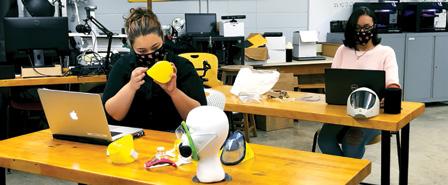
koehler fieldhouse renovation benefits students and community
After extensive renovations, ESU’s Koehler Fieldhouse is ready for the best of times – graduations, basketball games, concerts – and the worst of times, including 2012 when Koehler was used as a megashelter for people in the region who needed temporary housing following Hurricane Sandy, or more recently in 2020 when the facility was setup to serve as a COVID-19 field hospital. That’s what the Monroe County Commissioners had in mind when they earmarked $1.3 million of the $15.4 million the county received from the federal CARES Act to pay for an air conditioning system at Koehler Fieldhouse that will enable ESU students and the greater community to have clean, fresh, cool air when necessary – especially during warm spring and summer months, when the facility is used on excessively hot days for athletic practices, to welcome large groups for commencement ceremonies and other community events, and in regional emergency situations. The new air conditioning unit adds additional value in light of the pandemic; it has the capability of increasing the rate of air change, reducing air recirculation and increasing the amount of outdoor air to thwart the spread of COVID-19. A new 550-kilowatt generator, funded by a $360,000 grant from the Pennsylvania Emergency Management Agency (PEMA), ensures the Fieldhouse will retain electricity during power outages like the one that left Monroe County residents without power for three days in March 2017. “The addition of a generator and air conditioning system to Koehler Fieldhouse maximizes the functionality of the building, not only for the campus but for the community,” said Mary Frances Postupack, ESU vice president of economic development and entrepreneurship, who spearheaded the effort to obtain funding for both initiatives. Sharon Laverdure, chair of the Monroe County Commissioners, agreed, saying Koehler’s location, size and facilities make it a logical shelter for large emergencies, in part due to its proximity to Lehigh Valley HospitalPocono, the downtown, bus routes and major thoroughfares, such as I-80. “In case of an emergency, Koehler Fieldhouse can impact virtually every citizen in Monroe County,” Laverdure said. “If something terrible happens, it is there for the community as an emergency shelter.” Early in the coronavirus pandemic, the nearly 85,000-square-foot fieldhouse built in 1966 was designated as an “alternate-care site” that could accept 200 patients recovering from COVID if the region’s hospitals became overwhelmed. Because air conditioning was not available, temporary units were rented and installed. Fortunately, Koehler wasn’t needed but having the permanent COVIDfiltering air conditioning and ventilation system, plus the generator, will ensure its readiness for future emergencies. Thomas Hughes, PEMA state hazard mitigation officer, said “the PEMA investment in a generator in Koehler Fieldhouse expands the functionality and reliability of the fieldhouse for potential emergency situations. It is important to maintain a statewide inventory of state-affiliated and supported locations.” The renovation of the 46,000-square-foot arena includes a new foursided scoreboard with high-definition video screens, flooring and a fresh painting of the ESU Warrior. NCAA college basketball now requires arenas to have scoreboards that are more technologically sophisticated than Koehler’s previous 1994 scoreboard with its analog technology.
The new four-sided scoreboard with high-definition video was part of the project.
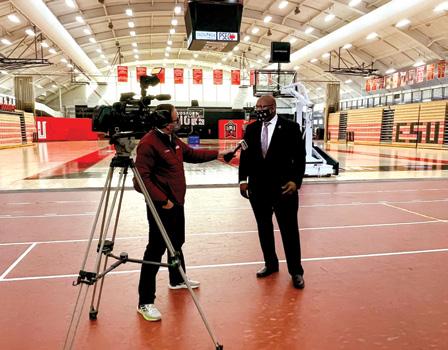

Interim President Kenneth Long interviewed by local media in April about the renovations at Koehler Fieldhouse.
“The scoreboard upgrade was a must,” said Dr. Gary R. Gray, ESU director of athletics. “It was a heavy financial lift for the university, but we anticipate recouping the cost through scoreboard advertisements, sponsorships and facility rentals. Restoration of the arena floor became necessary after the COVID field hospital was on site.” ESU Interim President Kenneth Long stated that the upgrades will benefit not just university students and teams but also members of the public who use the fieldhouse for activities ranging from voting poll stations to basketball tournaments to fitness testing for law enforcement. “There are various first responder and military agencies, not just in our county but in surrounding counties, that do their fitness testing at ESU,” he said. “The indoor track in January is indispensable when there are 10 inches of snow outside.” Popular community events regularly held at Koehler include the Perryman Keglovits Foundation’s annual basketball game for all-stars from area high schools. Event proceeds go to the Dale and Frances Hughes Cancer Center at Lehigh Valley Hospital – Pocono. There are also long-standing camp contracts with organizations that use ESU’s facilities for youth programs and other community events. – By Margie Peterson
WHAT’S STill To come for KoeHler?
Additional updates to Koehler are in the works, including the installation of a new sound system that will improve the quality of sound throughout the arena for important events like graduation, and will also aid in providing effective communication with large groups in the course of an emergency. Also planned is a life-cycle renovation and upgrade of the football locker room, which is the focus of a fundraising campaign led by head coach Jimmy Terwilliger and a committee of current and former coaches and athletes, with help from the ESU Foundation. The locker room project is expected to be completed before the 2021 season begins.
commencement rEtUrnS
grAduATing WArriorS celebrATe THe culminATion of A memorAble yeAr
Six Commencement ceremonies were held for ESU Warriors over two weekends. Following guidelines for social distancing, ESU assembled the ceremonies by college and held five in Eiler-Martin Stadium on May 1, 7 and 8. The Doctoral Ceremony was held April 30 in the Abeloff Center for the Performing Arts.
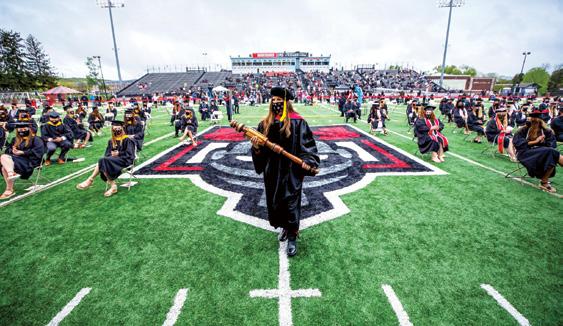
Graduates of the College of Health Sciences participate in Commencement in Eiler-Martin Stadium on May 8, 2021. Photo by Susie Forrester
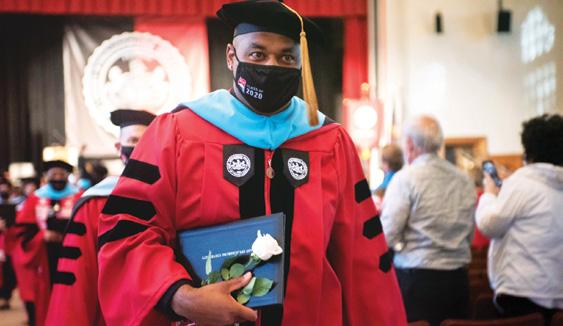
InclusIon Poster Project
returns iN viRTuAl, 3D exhiBiT
The COVID-19 pandemic and primarily remote learning upset student life in 2020 as never before. But so did national unrest surrounding racial injustice, along with the resurgence of the Black Lives Matter movement. Both disruptions were the focus of the 2020 Inclusion Poster Project, a collaboration between philosophy and graphic design students at ESU, In its third year, the goal of the project was for students from different disciplines to work together, come up with a message and design that encourage ESU’s commitment to create a welcoming environment for a diverse community. “Students designed images and messages that reflected specific strategies of inclusion,” says T Storm Heter, Ph.D., the philosophy professor whose Race, Gender and Culture class came up with concepts for the project this year. “I feel that since we — students and professors alike — were all undergoing many of the same stressors together, and not being in the same physical location, this enabled us to have much more intimate conversations than in the past,” says art + design professor David Mazure, whose Graphic Design students created the posters. In past years, the inclusion posters were carefully placed in critical gathering spots around campus. But the events of 2020, in addition to focusing the themes of the designs, meant the project resulted in an online-only display for the first time. This year’s inclusion posters — 19 in all — are mounted in a virtual exhibit through the Madelon Powers Gallery which allows visitors to navigate through and examine the art in a 3D experience that includes detailed looks and descriptions. Many of the posters depict computer screens and the now-familiar look of an online meeting, and address the frustration, confusion, depression, sleeplessness and anxiety a “virtual” education can cause. Other posters feature images from the Black Lives Matter protests and inequities experienced by people of different races, backgrounds and gender types. Charlie Skeet, a junior art + design student, created a striking poster in collaboration with philosophy students Zebulon Kleintop and Desiree Felts. The piece features a quote from writer James Baldwin about facing the need for change and a collection of hateful words targeted at Black people. “We all thought that the Black Lives Matter movement No Matter Who You Are was something that should be brought to attention,” Skeet says. “While the other designers chose to focus on a more positive message, I felt there were other things that needed to be addressed before coming to a peaceful conclusion.” “I’m a Black American, so waking up to see injustice day after day was not only Don’t Be Afraid To Speak alarming because I was scared for myself and my family, but Your Mind it was heartbreaking to see all the innocent lives that were lost because of the police brutality, the treatment of Black LGBTQIA+ community, outright racism, and a number of other incidents.” “From microaggressions and slurs to stereotypes and prejudices, we face them all,” Skeet says. Demarese Burley, a senior counseling psychology major, worked on posters with two design students, Christian Borrero and Dominique Marrillo. “I threw the idea out to my group that we should consider the mental health issues students are facing in the world of Zoom and COVID-19,” says Burley, who is looking for a career as a high school guidance counselor. Both of the posters she contributed to address challenges student face with the working world. Borrero’s poster depicts the stress facing students who work full-time jobs while pursuing a college degree, with the message “Work for eight hours/Study for eight more.” Marrillo’s poster confronts the generational divide. “Meaning, the older generations who have already established their careers telling younger generations everything will be OK, yet how can we be sure of that when we can’t even get internships?,” Burley says. Joanne Bruno, J.D., ESU’s provost and vice president for academic affairs, says the project was designed to use students’ own experiences to stimulate discussion about social acceptance and challenges. “Many of the posters deal with difficult issues, but they are educational in focus,” Bruno says, noting how the project was an opportunity for students to exercise their freedom of speech while creating courageous and intelligent dialogue about diversity and inclusion on campus. “The collaboration was excellent,” Heter says. “The philosophers learned how to think visually and the design students benefited from the philosophers’ work in feminist and critical race studies.” After an initial large group meeting online, the students were paired up. Philosophy students suggested a theme and their concerns about exclusion. The designers sketched ideas, both digitally and in traditional media, and they went back and forth until both students were satisfied with the final poster.
view the 2020 esu inclusion poster project in the online madelon powers gallery:
esu.edu/madelon-powers/exhibitions/inclusion-poster-project/index.cfm
PublIc hIstory, data scIence ADDeD TO CeRTifiCATe pROGRAMS
Two new certificate programs in the College of Arts and Sciences have been announced. A post-baccalaureate graduate certificate in public history and a certificate in data science will both be offered beginning the fall 2021 semester. Both will be offered face-to-face. To learn more about the certificates, and all the offerings in ESU’s College of Arts and sciences, contact dr. basu at 570-422-3449 or email abasu1@esu.edu.
JOANNE ZAKARTHA BRuNO, J.D.
After six years of leading the academic arm of ESU, provost and vice president for Academic Affairs Joanne Zakartha Bruno, J.D., announced her retirement effective late summer 2021. Provost Bruno began her role as provost at ESU in March 2015. She has been involved in championing a significant number of academic initiatives at the University during her tenure including; leading the creation and implementation of several academic programs including ESU’s first two doctoral programs (education and health sciences), as well as two master’s, four bachelor’s degrees and 18 certificate programs and launching ESU’s Provost’s Colloquium series. Under Bruno’s leadership and in collaboration with the Diversity and Inclusion Committee, ESU has increased its efforts and results by hiring faculty of color and other diverse faculty in an effort to ensure a diverse and inclusive learning environment. “I have had the pleasure to work with Provost Bruno as both a vice president and now as interim president,” said Kenneth Long, ESU’s interim president. “As vice president of administration and finance I always admired her ability to handle the enormous task of managing the academic environment on a daily basis coupled with her ability to envision the future of education for students at ESU and within the State System. More personally, as interim president, I have witnessed Jo’s deep compassion for her colleagues and the students she serves, especially during the COVID-19 pandemic. We will miss her.” Prior to her work at ESU, Bruno worked in the office of academic affairs at New Jersey City University for close to 20 years, including roles as the vice president for Academic Affairs and the vice president of Academic Initiatives and Services. She earned her J.D. from Rutgers University Law School in Newark, N.J. in 1987, practicing in N.J. for 9 years.
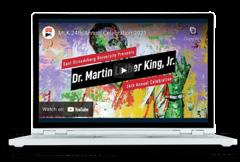
CHRiSTOPHER T. BROOKS, DR. PHiL.
Appointed by the U.S. Commission on Civil Rights to the Pennsylvania Advisory Committee. Brooks will be one of 15 Pennsylvanians selected to work in that advisory role. His term began in December 2020 and will run for four years. Brooks earned a dual bachelor’s degree in history and philosophy and master’s degree in American history, both from ESU. He completed extensive academic work at Edinburgh University in Scotland and completed his doctoral work at the University of Kassel in Germany, focusing on legal and constitutional history, in 2006.
CHRiSTOPHER H. DuBBS, PH.D.
Published a book titled “Mathematics Education Atlas: Mapping the Field of Mathematics Education Research,” published through Crave Press. This research book examines mathematics research with a humanities approach. Dubbs follows in the genealogical tradition of Michael Foucault by looking back at the emergence of the field called mathematics education research and tracing the foci of study across time. Dubbs is a graduate of Michigan State University where He received a Ph.D. in mathematics education and a master’s in industrial mathematics. He received a bachelor’s in mathematics from Lock Haven University of Pennsylvania.
KiMBERLy S. ADAMS, PH.D.
Elected to the board of directors for the National Organization for Women (NOW) in Washington, D.C. She was elected to serve the Northern district which includes Connecticut, Maine, Massachusetts, New Hampshire, New Jersey, New York, Pennsylvania, Rhode Island, and Vermont. Adams earned her bachelor’s and master’s degrees in political science at the University of Southern Mississippi and earned her doctorate in political science at the University of Mississippi. At ESU, Dr. Adams’ classes focus on racial and ethnic politics, campaigns and elections, women and politics, political communication, and American Government. She serves as ESU campus liaison to the Pennsylvania Center for Women and Politics and the Osgood Center for International Studies. She is also the advisor to the Political Science Club.
DR. CLAiRE Lu
Selected as ESU’s first Fulbright Scholar-In-Residence for 2021-2022 academic school year. She is the director and chair of the department and graduate school of tourism management for the business school at the Chinese Culture University in Taiwan. Lu earned her bachelor’s degree in psychology from the National Cheng-Chi University, a master’s degree in education and human development from George Washington University, a doctorate from Rutgers University and a second doctorate from the School of International Business Management at the Chinese Culture University in Taiwan. Lu will teach courses in Perspectives of International Tourism and Meeting and Convention Planning and Management at ESU, based on her expertise in the field of travel and tourism management.
MartIn luther KIng, jr., celebratIon goes vIrtual In 2021
The ESU community connected virtually on Jan. 18, 2021, for the 24th Annual Martin Luther King, Jr., Celebration, honoring the legacy of King and recognizing this year’s award winners. Begun in 1997 by former President Robert Dillman, the event is one of the most significant and symbolic for the entire Pocono Region. Marcus Narcisse ’20, who majored in special education and rehabilitative services from Orange, N.J., received the Martin Luther King Jr. Student Award. R. Samantha Williams, a counselor/instructor in ESU’s Counseling and Psychological Services department from Mt. Pocono, Pa., was the recipient of the 2021 Staff Award, and Christa Caceres, president and political action committee chair of the Monroe County Branch of the NAACP from Bushkill, Pa., received the Community Award. Sarah Batool Khan ’15, senior curriculum training developer at an anti-sexual violence organization based in Washington, D.C., gave the keynote address, speaking to the event theme: “We must accept finite disappointment, but never lose infinite hope.” to view the virtual event, visit esu.edu/mlk/index.cfm.




